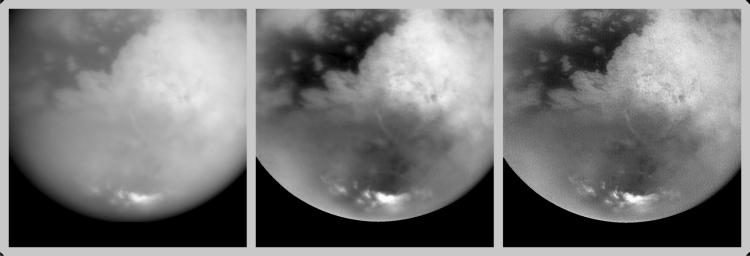Revealing Titan’s Surface
Caption:
These three pictures were created from a sequence of images acquired by Cassini's imaging science subsystem on Oct. 25, 2004, 38 hours before its closest approach to Titan. They illustrate how the details of Titan's surface can be revealed through image processing techniques.
The picture on the left is a single image that has undergone only basic cleaning of corrupted pixels and imperfections in the camera's charge coupled device, a light-sensitive detector similar to those found in digital cameras. In the middle frame, multiple images were used to enhance the contrast detected from Titan's surface and to reduce the blurring effect of atmospheric haze. The picture on the right has been further processed to sharpen the edges of features.
The processed images reveal sharp boundaries between dark and light regions on the surface; there are no shadows produced by topography in these images. The bright area on the center right is Xanadu, a region that has been observed previously from Earth and by Cassini. To the west of Xanadu lies an area of dark material that completely surrounds brighter features in some places. Narrow linear features, both dark and bright, can also be seen. It is not clear what geologic processes created these features, although it seems clear that the surface is being shaped by more than impact craters alone. The very bright features near Titan's south pole are clouds similar to those observed during the distant Cassini flyby on July 2, 2004.
The region on the left side of these images will be targeted by higher-resolution observations as Cassini passes close to Titan on Oct. 26, 2004.
All of these images were acquired by Cassini on Oct. 25, 2004, at an altitude of 702,000 kilometers (436,000 miles) and a pixel scale of 4.2 kilometers (2.6 miles). The Sun was illuminating Titan from nearly behind the spacecraft.
Background Info:
The Cassini-Huygens mission is a cooperative project of NASA, the European Space Agency and the Italian Space Agency. The Jet Propulsion Laboratory, a division of the California Institute of Technology in Pasadena, manages the Cassini-Huygens mission for NASA's Office of Space Science, Washington, D.C. The Cassini orbiter and its two onboard cameras, were designed, developed and assembled at JPL. The imaging team is based at the Space Science Institute, Boulder, Colo.
For more information, about the Cassini-Huygens mission visit,
http://saturn.jpl.nasa.gov
and the Cassini imaging team home page,
http://ciclops.org
.
Cataloging Keywords:
| Name |
Value |
Additional Values |
| Target |
Titan |
|
| System |
Saturn |
|
| Target Type |
Satellite |
|
| Mission |
Cassini-Huygens |
|
| Instrument Host |
Cassini Orbiter |
|
| Host Type |
Orbiter |
|
| Instrument |
Imaging Science Subsystem (ISS) |
|
| Detector |
|
|
| Extra Keywords |
Atmosphere, Crater, Grayscale, Haze, Impact, Shadow |
| Acquisition Date |
|
| Release Date |
2004-10-27 |
| Date in Caption |
2004-07-02 |
2004-10-25, 2004-10-26 |
| Image Credit |
NASA/JPL/Space Science Institute |
| Source |
photojournal.jpl.nasa.gov/catalog/PIA06125 |
| Identifier |
PIA06125 |

 Planetary Data System
Planetary Data System
